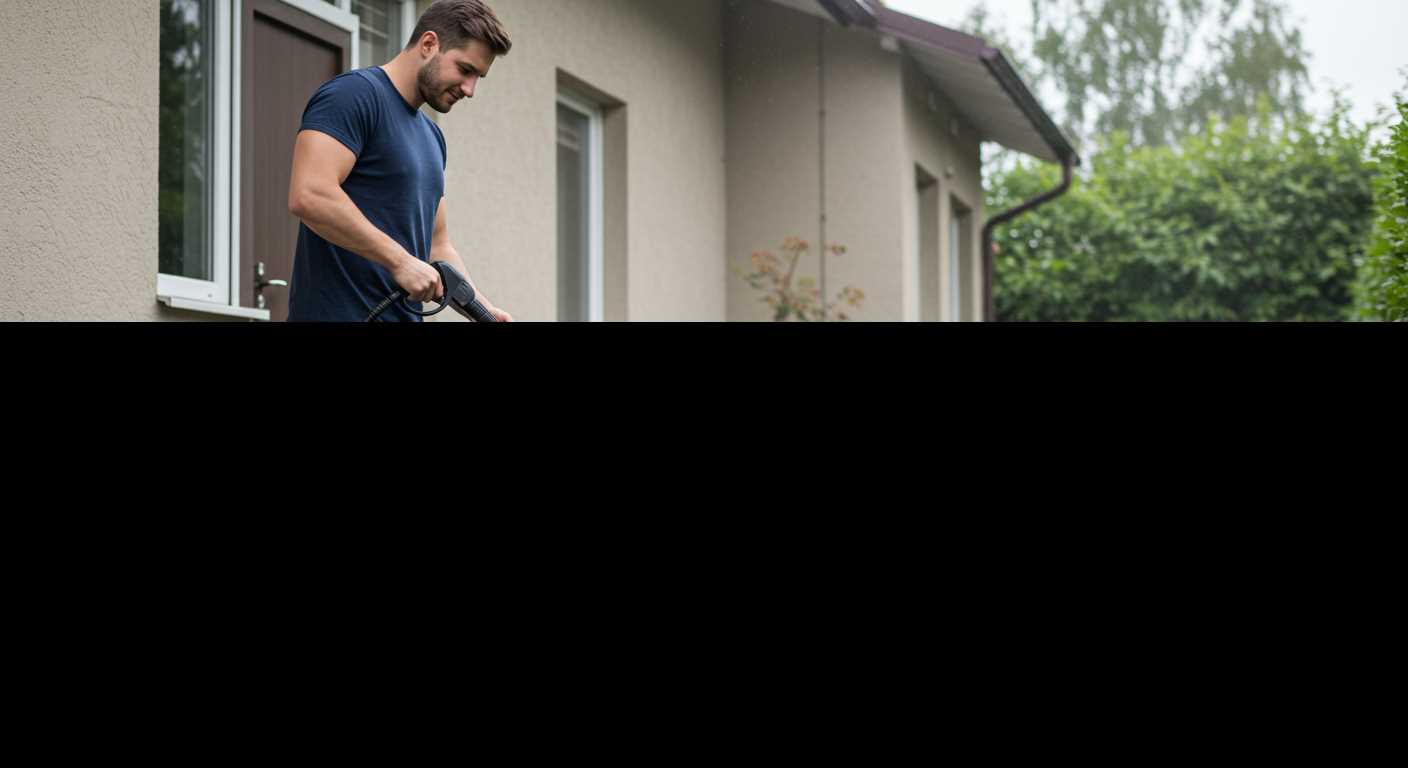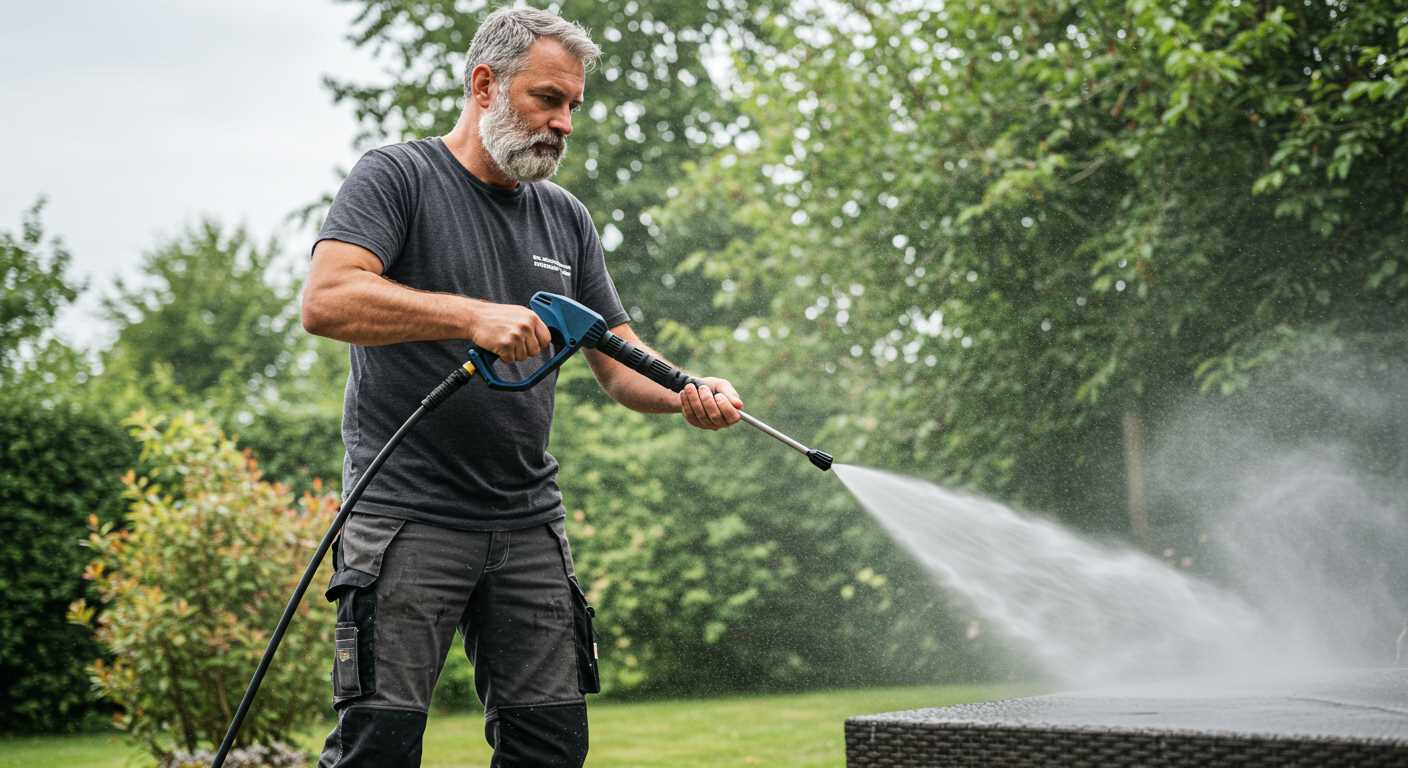



Begin with keeping the equipment clean and well-maintained. Regular inspection, especially of the hose and nozzle, prevents blockages and maintains optimum functionality. Clear any debris from the inlet filter and make sure all attachments are secured before each use.
For outdoor surfaces, employ the right detergent suitable for the task. Mix according to the manufacturer’s guidelines and apply from the bottom to the top. This method ensures dirty water runs downwards, resulting in a more efficient cleaning process. Rinse thoroughly using a fan spray to avoid streaks and residue.
Adjust the pressure according to the surface material being cleaned. A lower setting is recommended for softer materials like wood, while a higher pressure works for concrete or brick. Keep a steady distance, approximately 30–45 cm, from the surface to prevent damage.
Finally, experiment with different nozzle types. Wide-angle nozzles are ideal for large areas, while narrow nozzles provide targeted cleaning. Switching between options can enhance performance and efficiency during various tasks.
Understanding Your Wilks USA Pressure Washer Model
Before operating your equipment, it’s crucial to identify the specific model you possess. Each variant may feature different pressure ratings, flow rates, and functionalities. Check the user manual for detailed specifications related to your particular unit.
For optimal performance, ensure that the appropriate nozzle is attached. Each nozzle serves a unique purpose–wider angles for delicate surfaces and narrow tips for tougher grime. By selecting the right one, you’ll enhance the cleaning process significantly.
Maintenance Insights
Regular maintenance prolongs the lifespan of your machine. Begin with routine checks on the water filter and hose connections. Clogged filters can reduce water flow, impacting performance.
Inspect the pump oil level; this should be changed according to the manufacturer’s recommendations found in your manual. Adequate lubrication is key to preventing premature wear and tear.
Operational Tips
To achieve the best results, start with an area test. Spray a small section before proceeding to ensure the desired pressure level is appropriate for the surface being cleaned. This helps prevent any damage that may occur due to excess force.
After completing your washing tasks, empty any residual water from the system. This prevents water from freezing inside the pump during colder months and maintains optimal functionality.
Knowledge of your specific unit can dramatically enhance your cleaning efficiency. Make adjustments as necessary, and stay informed about any updates or recalls associated with your model.
Preparing for Cleaning Tasks: Equipment and Safety Gear

Before starting with the cleaning device, it’s vital to gather the necessary equipment and protective clothing. Here’s what you’ll need:
Required Equipment

- Cleaning solution compatible with the surface type.
- Extension cords rated for outdoor use, if necessary.
- Surface attachments for varying tasks, like nozzles for delicate surfaces.
- Cleaning pads or brushes to support heavy-stained areas.
Personal Protective Equipment (PPE)
- Safety goggles to protect eyes from debris and splashes.
- Water-resistant gloves to avoid skin irritation from cleaning agents.
- Slip-resistant footwear to prevent accidents on wet surfaces.
- Protective clothing such as long sleeves and trousers.
Inspecting gear before operation is critical. Look for wear and tear on hoses and connections, and ensure that safety devices are functioning correctly. This preparation enhances efficiency and minimizes risk during cleaning tasks.
Connecting the Cleaner to Water and Power Supply
First, ensure the cleaner is placed on a flat, stable surface away from obstacles. Check that the machine is switched off before proceeding. Start by connecting the garden hose to the water inlet. The water supply must be clean, and a filter is recommended to prevent debris from entering the unit. Tighten the connection to avoid leaks.
Next, run the hose until water flows steadily from the nozzle. This step removes any air in the system, ensuring optimal performance. After confirming a steady flow, attach the high-pressure hose to the outlet. Make sure this connection is also secure to prevent any mishaps during operation.
For power supply, locate the power cord. It should be plugged into a grounded outlet with the appropriate voltage, usually 230V. Avoid using extension cords if possible, as they may reduce the voltage and affect performance. Ensure the electrical cord is free from damage and not frayed.
Before turning on the machine, double-check all connections. Inspect the water supply and power cord to ensure everything is in order. Once satisfied, you can switch on the device to begin your cleaning tasks efficiently. Following these steps enhances safety and machine longevity.
Selecting the Right Nozzle and Pressure Setting

Choosing the appropriate nozzle is critical for achieving optimal results. Different nozzles alter the spray pattern and pressure, allowing me to tailor the cleaning process to specific surfaces. I recommend keeping the following table at hand for a quick reference:
| Nozzle Colour | Spray Angle | Pressure Setting | Surface Type |
|---|---|---|---|
| Red | 0° | Maximum | Heavy-duty cleaning (e.g., graffiti removal, oil stains) |
| Yellow | 15° | High | Concrete, brick, and similar hard surfaces |
| Green | 25° | Medium | Decks, siding, and vehicles |
| White | 40° | Low | Gentle cleaning for delicate surfaces (e.g., windows) |
| Black | Soap | N/A | For applying detergent |
After selecting a nozzle, it’s crucial to adjust the pressure setting appropriately. For lighter tasks, like washing cars or garden furniture, a lower setting suffices. Higher pressure is necessary for stubborn stains on hard surfaces like concrete. Always begin with the lowest setting to assess the surface tolerance before increasing the pressure, avoiding potential damage.
Lastly, maintaining an optimal distance from the surface is key. Generally, I keep a distance of 2-3 feet for most jobs, adjusting based on the results and the specific nozzle used. This approach prevents damage while ensuring thorough cleaning.
Techniques for Cleaning Different Surfaces
For concrete, begin with a detergent suitable for tough stains. Use a 15-degree nozzle, maintaining a distance of around 12 inches from the surface. Move the lance in overlapping passes to avoid streaks, and always rinse thoroughly afterwards.
Wood Surfaces
For wooden decks or fences, select a 25-degree or soap nozzle. Keep the nozzle at least 24 inches away and use a sweeping motion to prevent damage. Start at one end and work your way across evenly. Always test in a small area first.
Vehicles
When cleaning cars or bikes, opt for a foam attachment with a soap nozzle. Apply detergent generously, allowing it to dwell for a few minutes. Rinse with a 40-degree nozzle from a safe distance of about 2 feet. Avoid high pressure directly on sensitive areas such as windows and paintwork.
- Brick and Stone: Use a narrow nozzle to tackle grime effectively, and maintain a 12 to 18-inch distance.
- Vinyl Siding: For gentle yet thorough cleaning, employ a 25-degree nozzle and soap for optimum results.
- Fencing: Avoid damaging the surface by using a wider nozzle and conscious distance handling.
Always assess the surface condition prior to starting. Adjust pressure and nozzle size accordingly for the best outcome.
Maintenance Tips After Using Your Pressure Cleaning Equipment
Flush the machine by running clean water through it for a few minutes. This step ensures that any detergent remnants or debris are removed from the system, helping to maintain optimal performance.
Cleaning Components
Disconnect the water supply and power source, then inspect and clean the nozzle and filter. A clogged nozzle can impede water flow and pressure. Use a soft brush or compressed air to clear any blockages. Check the filter for dirt and rinse it thoroughly under running water.
Storing Your Equipment
After cleaning, store the unit in a dry, frost-free environment. Ensure the hose is coiled properly and not kinked, which could lead to damage. Additionally, consider using a cover to protect the equipment from dust and moisture.
Inspect all attachments and accessories for wear or damage. Replace any worn parts promptly to avoid further issues during your next operation.
Troubleshooting Common Issues with Pressure Cleaning Equipment
If your machine fails to start, check the power supply first. Ensure that the unit is plugged in securely and that the outlet is functioning. A blown fuse or tripped circuit breaker can also be culprits.
Should you notice a reduction in water pressure, examine the nozzle for blockages. Clear any debris using a thin object, ensuring that water can flow freely. Additionally, inspect the hoses for kinks or leaks; replacing damaged hoses can restore performance.
If there’s an excessive amount of foam or a detergent leak, verify that the soap tank is properly sealed and that the detergent used is compatible with your model. Diluting the detergent or switching brands can often resolve the issue.
For abnormal sounds during operation, such as rattling or grinding, turn off the equipment immediately to prevent damage. Check for loose components or foreign objects stuck in the motor. Tightening screws or removing any obstructions can often rectify the problem.
Persistent starting difficulties may indicate fuel or oil issues. Confirm that the fuel tank is filled and check the oil level as per the manufacturer’s guidelines. A dirty air filter can impede performance; clean or replace it as necessary.
If the unit vibrates excessively, inspect the feet and ensure they are stable and secure on the ground. An unstable surface can lead to vibrations that affect performance.
In cases where the equipment continues to operate unsatisfactorily, consulting the user manual can provide specific guidance tailored to your model. Regular maintenance, including cleaning filters and checking connections, can prevent many issues before they occur.







